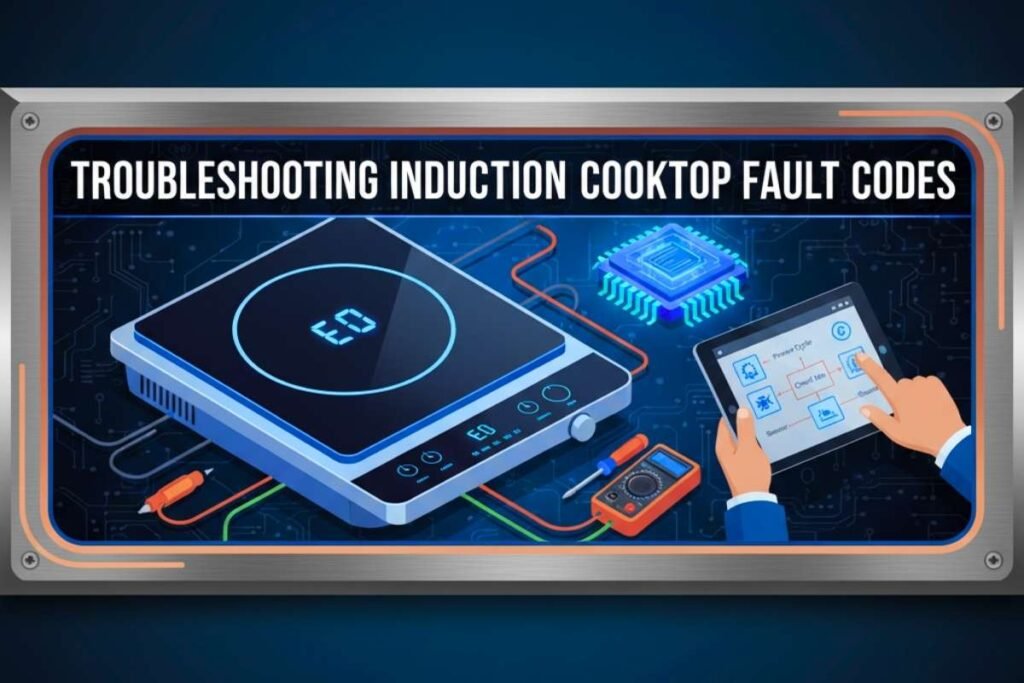That sinking feeling is all too familiar: you’re midway through preparing a meal, and suddenly your sleek, efficient induction cooktop starts beeping, flashing a cryptic code, and stops heating. It’s a moment of pure frustration. However, these error codes aren’t a sign of complete failure; they are your appliance’s way of communicating a specific problem.
Think of this guide as your universal translator for induction cooktop fault codes. We have compiled a comprehensive diagnostic manual that covers common errors across major brands available in Australia, including Bosch, Samsung, Technika, Fisher & Paykel, and Gaslandchef. From simple resets to identifying specific component failures, this is your complete guide to troubleshooting induction cooktop error codes, understanding the message, and finding the right solution.
Universal First-Response Actions
Before delving into specific codes, a few universal troubleshooting steps can resolve a surprisingly high number of common faults. Always perform these actions first.
1. The “Hard Reset” (Power Cycle)
This is the single most effective first step for any electronic appliance fault. A proper hard reset clears the cooktop’s temporary memory (volatile memory) and can resolve minor electronic glitches.
-
Step 1: Go to your home’s main switchboard (fuse box).
-
Step 2: Locate the circuit breaker switch dedicated to your cooktop. It should be clearly labelled.
-
Step 3: Switch the breaker to the “OFF” position.
-
Step 4: Wait for at least 60 seconds. This is crucial to ensure all residual power dissipates.
-
Step 5: Switch the breaker back to the “ON” position. Return to your cooktop and check if the error has cleared.
2. Surface and Control Panel Inspection
Induction cooktops use touch-sensitive controls that can malfunction if obstructed.
-
Check for Moisture: Carefully wipe down the entire glass surface and control panel with a dry, soft cloth. Even a small amount of water or condensation can trigger an error.
-
Check for Objects: Ensure no utensils, tea towels, or other items are resting on the control panel.
-
Check for Debris: Look for food spills or boil-overs, especially around the edges of the control panel, and clean them away.
3. Cookware Compatibility Check
Induction cooking works via a magnetic field. If the cookware isn’t compatible, the cooktop won’t heat and may display an error.
-
The Magnet Test: Take a standard fridge magnet and try to stick it to the base of your pot or pan. If the magnet sticks firmly, the cookware is induction-ready. Materials like magnetic-grade stainless steel and cast iron are ideal. Aluminium, copper, or glass cookware will not work.
-
Check Pan Size and Placement: Ensure the base of the pan is large enough for the cooking zone and is placed centrally on the ring. A pan that is too small or off-centre may not be detected.
4. Ventilation Check
Overheating is a primary cause of many fault codes. Your cooktop needs to breathe to keep its internal electronics cool.
-
Inspect the ventilation slots, usually located at the front, back, or sides of the unit. Ensure they are free from dust, grease, and are not blocked by cabinetry, wall coverings, or stored items.
Comprehensive Error Code Directory
If the first-response actions didn’t solve the issue, it’s time to identify your specific error code. We’ve grouped them by common families (F-Series for ‘Fault’, E-Series for ‘Error’, U-Series for ‘User/Voltage’) and symbols.
F-Series (General Fault Codes)
These often relate to temperature, sensor, or operational faults.
-
Error Code(s): F1 / F6
-
Commonly Seen On: Bosch and other European models.
-
Diagnosis: The cooking zone has overheated and shut down to protect the work surface and internal components.
-
Underlying Cause: This typically happens if an empty pot or pan is left on a high heat setting for too long, or if the ventilation is inadequate.
-
User Actions:
-
Remove the cookware from the affected cooking zone.
-
Turn the cooktop off and allow it to cool down completely for at least 30 minutes.
-
Ensure the ventilation slots are clear.
-
Once cool, perform a “Hard Reset” as described in Section 2.2.
-
-
When to Call a Professional: If the error reappears immediately on a cool cooktop or during normal use with proper cookware.
-
-
Error Code(s): F2 / F4 / E7015
-
Commonly Seen On: Bosch.
-
Diagnosis: The internal electronics have overheated. The corresponding cooking zone (or the entire unit) has switched off.
-
Underlying Cause: This is more serious than a cooking zone overheating. It points to insufficient ventilation for the internal electronics or a potential failure of the cooling fan.
-
User Actions:
-
Immediately turn off the cooktop at the main power point or circuit breaker.
-
Check and clear any obstructions from all ventilation grilles.
-
Allow the appliance to cool for at least one hour.
-
Restore power and test.
-
-
When to Call a Professional: If the error code returns, a service technician is needed to inspect the internal cooling fan and control boards.
-
-
Error Code(s): F3 / F4
-
Commonly Seen On: Gaslandchef, Technika, various generic models.
-
Diagnosis: Temperature sensor of the induction coil has failed.
-
Underlying Cause: The sensor that monitors the heat of a specific cooking coil is reporting an out-of-range reading or has failed entirely. This is an internal hardware fault.
-
User Actions: Perform a “Hard Reset” to rule out a temporary glitch.
-
When to Call a Professional: If the error code returns after a reset, this requires a technician to replace the faulty sensor. Do not attempt this yourself.
-
-
Error Code(s): F5 (Flashing Power Level & Beeping)
-
Commonly Seen On: Bosch, Samsung.
-
Diagnosis: Hot cookware is detected too close to the control panel. This is a warning to prevent damage to the electronics.
-
Underlying Cause: A large pot is overhanging the cooking zone and covering part of the touch controls, or you have placed a hot lid or utensil on the control area.
-
User Actions: Immediately remove the cookware or hot object from the control panel. The beeping should stop, and you can continue cooking.
-
When to Call a Professional: Service is not typically required unless the error persists even with no cookware on the surface.
-
-
Error Code(s): F8 + H/h
-
Commonly Seen On: Bosch.
-
Diagnosis: The automatic time limitation has been triggered. A cooking zone has been operating for an extended period without any interaction.
-
Underlying Cause: This is a safety feature to prevent the cooktop from being left on indefinitely by accident.
-
User Actions: Simply touch any control on the cooktop to acknowledge you are still present. You can then continue cooking as normal.
-
When to Call a Professional: This is not a fault; no service is needed.
-
-
Error Code(s): F9 / FA
-
Commonly Seen On: Gaslandchef, Technika.
-
Diagnosis: Temperature sensor for the IGBT (Insulated-Gate Bipolar Transistor) has failed.
-
Underlying Cause: The IGBT is a critical power-switching component. Its temperature sensor has failed, and the cooktop has shut down for safety.
-
User Actions: Perform a “Hard Reset”.
-
When to Call a Professional: This is a critical hardware failure. If the error code reappears, contact your supplier or a service technician immediately.
-
E-Series (Electrical & System Error Codes)
These usually relate to power supply, system communication, or more significant sensor issues.
-
Error Code(s): E1 / E2
-
Commonly Seen On: Gaslandchef, Technika.
-
Diagnosis: Abnormal power supply voltage.
-
Underlying Cause: The cooktop is receiving voltage that is either too high or too low for safe operation. This can be caused by issues in your home’s wiring or fluctuations in the local power grid.
-
User Actions:
-
Do not continue to use the cooktop.
-
Check other appliances in your home. If they are also behaving unusually, contact your electricity provider.
-
If only the cooktop is affected, switch it off at the breaker and contact a qualified electrician to inspect your home’s wiring.
-
-
When to Call a Professional: Always call an electrician for power supply issues. Do not attempt to fix this yourself.
-
-
Error Code(s): E3
-
Commonly Seen On: Gaslandchef, Technika.
-
Diagnosis: High temperature detected by the induction coil temperature sensor.
-
Underlying Cause: Similar to an F1/F6 error, this indicates a cooking zone is dangerously hot. This may be due to using an empty pot on high heat or a blocked vent.
-
User Actions: Follow the same steps as for F1 / F6 (cool down, check ventilation, reset power).
-
When to Call a Professional: If the code returns after cooling and a reset.
-
-
Error Code(s): E4 / E5
-
Commonly Seen On: Technika. (Note: E5 on Gaslandchef has a different meaning).
-
Diagnosis: Temperature sensor failure.
-
Underlying Cause: An internal temperature sensor has failed. This is a general fault code that may point to either the coil or IGBT sensor.
-
User Actions: Perform a “Hard Reset”.
-
When to Call a Professional: This requires diagnosis and component replacement by a technician.
-
-
Error Code(s): E6 / E9
-
Commonly Seen On: Technika.
-
Diagnosis: Poor heat radiation from the appliance.
-
Underlying Cause: The cooktop’s cooling system is not working effectively. This is almost always due to blocked ventilation grilles.
-
User Actions: Turn off the appliance. Thoroughly inspect and clean all air intake and exhaust vents around the unit. Allow it to cool before restarting.
-
When to Call a Professional: If the error persists after ensuring clear ventilation, the internal cooling fan may have failed.
-
-
Error Code(s): E9000 / E9010 / U400
-
Commonly Seen On: Bosch, Fisher & Paykel.
-
Diagnosis: The supply voltage is incorrect and outside the normal operating range.
-
Underlying Cause: Similar to E1/E2, this indicates a critical power supply problem.
-
User Actions: Turn off the cooktop immediately.
-
When to Call a Professional: Contact your electricity provider or a licensed electrician. This is not an appliance fault but a wiring or grid issue.
-
U-Series (User-Actionable Codes)
These codes often indicate an issue with how the cooktop is being used.
-
Error Code(s): U / Flashing Burner Indicator
-
Commonly Seen On: Many brands, including Samsung and Bosch.
-
Diagnosis: No cookware detected, or the cookware is not compatible/suitable.
-
Underlying Cause: There is no pot on the burner, the pot is not magnetic, the pot’s base is too small for the cooking zone, or it is not centred correctly.
-
User Actions:
-
Ensure a pot is placed on the cooking zone.
-
Confirm the pot is magnetic using the “Magnet Test” (Section 2.2).
-
Check that the pot’s base covers most of the burner ring.
-
Centre the pot correctly on the cooking zone.
-
-
When to Call a Professional: Only if the error shows even with multiple, confirmed-compatible pots placed correctly. This may indicate a faulty detection sensor.
-
Symbols and Text-Based Codes
-
Indicator: A steady Key Symbol LOCKED
-
Commonly Seen On: Bosch and others.
-
Diagnosis: The Child Lock feature is activated, preventing any controls from being used.
-
User Actions:
-
To Deactivate: Press and hold the “Key” symbol button for approximately four to five seconds until the light turns off.
-
To Activate: When the cooktop is off, press and hold the same key symbol for four to five seconds.
-
-
When to Call a Professional: Service is not required.
-
-
Indicator: dE on display
-
Commonly Seen On: Bosch.
-
Diagnosis: The cooktop is in “Demo Mode.” It will light up and appear to function, but the burners will not heat.
-
User Actions:
-
Disconnect the cooktop from power via the circuit breaker for at least 60 seconds.
-
Reconnect the power.
-
Within the first three minutes of restoring power, touch and hold the main power button or a specific combination of keys (consult your user manual) until “dE” disappears.
-
-
When to Call a Professional: This is not a fault; no service is needed.
-
-
Indicator: All displays are flashing
-
Commonly Seen On: Bosch, Samsung.
-
Diagnosis: The control panel is wet, or an object is covering it.
-
User Actions: Thoroughly dry the entire control panel or remove the object (utensil, cloth, etc.). The flashing should stop automatically.
-
When to Call a Professional: Service is not required unless the issue persists on a clean, dry, and unobstructed panel.
-
Symptom-Based Troubleshooting
Sometimes, your cooktop malfunctions without showing a clear code. Here’s how to troubleshoot common symptoms.
Why won’t my induction cooktop turn on?
-
Check that the circuit breaker at the switchboard is in the “ON” position.
-
Confirm the appliance isolator switch (often a separate switch on the wall near the cooktop) is turned on.
-
Make sure the Child Lock (key symbol) is not engaged.
Why is my cooktop beeping continuously?
-
This is the most common sign of a spill or an object on the control panel. Wipe the surface clean and dry.
-
It can also indicate that an unsuitable (non-magnetic) pot has been left on an active burner for too long. Remove the pot.
Why is only one burner not working?
-
Test that specific burner with a pot you know works on other burners to rule out cookware issues.
-
Ensure the pot is the correct size for that specific burner. Some burners have minimum size requirements.
-
Perform a “Hard Reset” to see if it clears a specific fault with that burner’s control board. If the issue persists, that burner’s coil or sensor may need servicing.
Maintenance and Prevention
A little care can prevent most common errors.
-
Cleaning: After the cooktop has cooled, use a soft cloth and a ceramic cooktop cleaner. For burnt-on food, use a specialised scraper tool designed for glass-ceramic surfaces. Never use abrasive sponges or harsh chemicals.
-
Cookware: Always use high-quality, flat-bottomed, magnetic cookware. Warped or damaged pans can cause poor heat distribution and detection errors.
-
Installation: When installing, ensure your cabinet maker has followed the manufacturer’s specifications for ventilation clearances. Proper airflow is the best defence against overheating errors.
By understanding these fault codes and symptoms, you can confidently diagnose and resolve most common induction cooktop issues, saving yourself time, money, and the stress of a half-cooked dinner.


